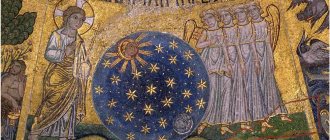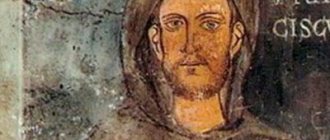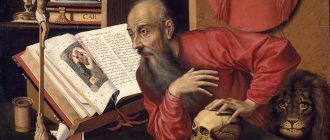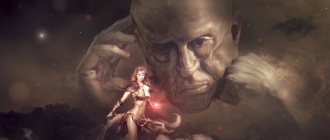The event called “the creation of the world” in religious literature is actually an astronomical event, timed to coincide with a specific date for a specific relative position of specific celestial bodies. Namely, on the date “5508 BC.” The center of the ecliptic, the position of the Earth’s rotation axis on the precessional trajectory, and the brightest star of the Northern Hemisphere, Arcturus, are lined up in one line.
This event became the starting point of the Old Russian calendar. As the ancient Rus spread to the countries of settlement of native peoples, the priests possessing astronomical knowledge were exterminated by the natives or mestizos (Semites), knowledge was mostly lost, and some of it from the astronomical sphere, due to misunderstanding, was transferred to the religious sphere and became the basis of the so-called "world" "religions".
Tyunyaev Andrey Aleksandrovich, academician of the Russian Academy of Natural Sciences,
source https://www.rusif.ru/vremya-istorii/gm-Russia/rus-vremya-do-ne/5508-Russia-Sotvorenie_mira.htm
The biggest mystery in chronology and the calendar is the date taken as the beginning of its countdown. It is called the same in all calendars - CREATION OF THE WORLD. This term is so difficult to interpret that today, despite the numerous studies in the field of mythology, calendar and history, there is no clear interpretation of it. The most ridiculous is the statement that supposedly Christian monks (or anyone else) added up the lifespans of all the Christian characters in the Bible and, on the basis of this, came to the figure “5508 BC,” which they allegedly called the “date creation of the world." Meaning, of course, the literal creation of the world according to the Christian interpretation.
Ancient Rus' in the Mesolithic - Neolithic
However, such constructions, including Christian ones, are incorrect, because archeology shows that even before the date of 5508 BC. life already existed on Earth. Of course, at that time there was neither Ancient Egypt nor Sumer [Tyunyaev, 2009]. But there was Ancient Rus'. In Central Rus' alone, there are more than 1200 Mesolithic settlements (15 - 6 thousand years BC) [AKR; Tyunyaev, 2010]. Moreover, it was not some humanoid creatures that lived, but a fully formed ancient Russian man.
These people knew how to make sleds and sleds, knew all types of fishing, knew how to make the most complex clothes, knew chemistry, knew how to make composite materials, including composite adhesives, which “hold” to this day [Zhilin, 2001; Tyunyaev A.A., 2010a]. And this is not fantasy. This is reality. You can literally touch it in any museum in Central Russia.
Rice. 1. Ancient people of the Russian Plain (reconstructions based on skeletal remains). Top row (from left to right): Sungirian 5 (ca. 25 thousand years ago); Reindeer Islander (6300 – 5600 BC); Upper Volzhevets (5240 – 3430 BC). Bottom row: two on the left – Volosovo people (3065 – 1840 BC); Afanasyevets (3rd – 2nd millennium BC).
One amazing find dates back to the same period of Ancient Rus' - an anthropomorphic figure with two faces [Zhilin, 2001]. On the website of the Peter the Great Museum of Anthropology and Ethnography of the Russian Academy of Sciences (www.kunstkamera.ru) this figurine is called “two-faced Janus.” This figurine was discovered in the Oleneostrovsky burial ground. This monument is the oldest and largest Mesolithic necropolis in the north-west of the Russian Plain.
It was located on South Oleny Island, 7 kilometers southeast of the famous Kizhi Island. According to radiocarbon dating, the burial ground functioned between 6300 and 5600 BC. and was used by people belonging to the archaic eastern branch of the Caucasians (see Fig. 1).
Rice. 2. Two-faced Reindeer Island “Janus”, from the time of creation of the world - 6300 - 5600 BC. (Roman coin with the image of two-faced Janus).
Paying attention to the coincidence of the dating of the burial ground and the date of the beginning of the calendar chronology “from the creation of the world,” we can assume that the calendar was actually introduced in the Mesolithic of the Russian Plain, and Jan (Janus) [Tyunyaev, 2009] was the deity of this calendar.
Chinese
In China, they believe that the Universe once had the shape of a huge chicken egg, in which the first ancestor Pangu was born. He slept in the egg for 18 thousand years, and when he woke up, he began to look for a way to get out. Pangu cut through the shell with an ax.
The two principles - the light one, formed by the Yang spirit, and the dark one, formed by the Yin spirit - became heaven and earth, respectively. Pangu stood on the ground and rested his head against the sky to prevent them from mixing again and turning into chaos. From his inhalations the winds rose, from his exhalations thunder roared, day came when the giant opened his eyes, and when he closed them, night fell. Every day Pangu grew 3 meters, making the sky higher and the earth thicker.
People came from parasites that crawled across the body of the Chinese ancestor Pangu. Pangu stood for 18 thousand years and died, and his voice became thunder, his sigh became wind and clouds, his left eye became the sun, his right eye became the moon, his body became the four cardinal points, his blood became rivers, and his flesh became soil. But people came from parasites that crawled around Pangu’s body.
About
Neolithic migrations of ancient Rus
Moreover, the middle of the 6th millennium BC. – this is not a simple date. This is the beginning of the formation of transgeographical trade routes [Chernykh, 1972; Tyunyaev, 2011], which reached China [Tyunyaev, 2011c]. It was at this time that the Great Migration of the Ancient Rus took place, and the so-called Indo-European family of languages began to form. The resettlement of the ancient Rus took place from the Moscow region: first to the southern Russian steppes, and then from there to the west, south and east.
Languages of the world (see stage from the 6th to the 5th millennium BC) [Tyunyaev, 2008].
Detachments led by Svarog [Chronicles, 1977; Tyunyaev, 2011a], in the 7th thousand they reached the Nile Valley in North Africa. Here they formed a local variety of archaeological cultures of painted ceramics - Kharif, Kholaf, etc. Sculptural images of Mother Mokosha have been found in all cultures, whose sculptural images have been known in Rus' since the 40th millennium BC. In genetic terms, the Hyperborean clan of Svarog was the carrier of haplogroup R1a1 - which more than 60 percent of the Russian population of Russia still possesses.
Daughter of Svarog - Volyn in 5 - 4 thousand BC. located her family in the Caspian steppes (previously the sea was called “Volynskoe”, then – “Khvalynskoe”, and then – “Caspian”). Archaeologically, these are the Khvalynsk, or proto-Kurgan and Kurgan cultures. The carriers apparently had the Atlantic haplogroup R1b. Her first ancestor lived 6775±830 years ago, that is, 5.5 - 3.9 thousand BC. The same haplogroup was recently discovered in their relative, the Egyptian pharaoh Tutankhamun [Tyunyaev, 2011a].
The son of Svarog - the Almighty - in 7 - 5 thousand BC. with his family R1a1 came to Armenia, where he created the first settlement of modern people. The first “Armenian” capital bore his name – Vishap (lit. City of the Most High). Throughout Armenia, more than two thousand monuments to the Almighty - Vishaps - have still been preserved. On each of them, the Almighty is schematically depicted in the form of a dragon-snake-vishap. The Son of the Almighty - Kryshen - advanced to Northern India, where he established himself in the form of gods and representatives of the highest castes.
The clan of Atlantean Rus went to the west and southwest and occupied a vast interfluve - between the rivers Don, Dnieper, Dniester, Danube, named after the head of the Atlantean clan - DON, the son of Koshchei. Archaeologically, this is the Trypillian culture and its Balkan variants. Genetically – Atlantic haplogroup R1b. And far to the southeast went the clan of Azhi-Dahak (7 - 6 thousand BC), a descendant of the serpent Yushi (Yazhe, She, Ash, etc.), holding the Earth [Tyunyaev, 2011c]. This clan settled in Northern Afghanistan. From him came the future Jews (ash-kenaz, R1a1).
The emergence and development of the calendar
For the first time, archaeologists encountered “ objects of art combined with iconic records of calendar and astronomical content ” during excavations in the city of Vladimir at the settlement of Sungir, 25 thousand years old [Larichev, 1997]. The astronomical and calendar purpose of Sungir products is also confirmed by specialists from the Vladimir-Suzdal Museum-Reserve (Vladimir), who also believe that the finds of Sungir indicate the existence of the Sungir in the 25th millennium BC. “ magic, worship of the sun and moon, lunar calendar and arithmetic calculation ” [Sungir, 1999].
We will not trace the entire chain of events associated with the penetration of the Sungir calendar into later layers of ancient Russian society, but note that the Russian calendar was abolished by Peter the Great only in 1700 AD. And it began with the date of the “creation of the world,” which was 5508 BC. This calendar did not belong to either the Christian or Jewish traditions - for it began long before them.
We showed above that archaeologically and mythologically this date correlates perfectly with real events: on this date the ancient Russian peoples began to diverge from a single center, forming painted ceramic cultures and the main families of languages. These peoples - descendants of the Atlantic ancient Russian roots - carried with them part of the knowledge that was formed back in the Sungir - Upper Paleolithic time.
Further, in the Mesolithic (15 - 7 thousand BC) the calendar tradition continued in the form of an ornament applied to various utensils, as well as specially made sculptural images of snakes and dragons (a dragon was originally depicted as a snake with an elk or later horse's head). In Fig. Figure 3 shows examples of such images. Let us pay attention to the fact that these crafts were discovered at the same monument as the two-faced “Janus”, which we wrote about above.
Rice. 3. Sculptural images of snakes and dragons - moose with snake bodies (Oleneoostrovsky burial ground, Mesolithic).
Many researchers have correlated the dragon serpent with the calendar and with an astronomical context. For example, the famous researcher of Russian antiquity A. N. Afanasyev wrote that the Russian people and the Slavs know two snake holidays a year, dividing the year into two equal parts. Both holidays are associated with the days of the spring and autumn equinox and are tied to the axis of the year, where spring and autumn are the two ends of this axis. The mythological vestment of this astronomical-calendar phenomenon was formed in the form of a snake, or snake, which was represented by the AXIS of the Earth. At the spring equinox, snakes crawled out of the ground, and at the autumn equinox they returned underground [Afanasyev, 1869].
Rice. 4. Occurring snakes (Tripillian culture, 3600 – 3100 BC).
The image of UZHA was fixed not only in the fact that he was the patron of the house, but also UZH was an intermediary between heaven and earth, an indicator of time. Therefore, an ornament of snakes is often found on vessels: two meeting snakes are two halves of an axis (Fig. 5, left), and two intersecting snakes (Fig. 5, right) divide the year into four parts. These parts were also distinguished in the form of four suns - they expressed the same idea of Time, important for farmers. On Trypillian vessels the sun and moon were used as signs of time: day after day, month after month. The four suns speak of the four solar phases of the year, and the entire vessel with his painting reflected the full annual cycle.
Rice. 5. Occurring and interbreeding calendar snakes (Trypillian culture, 3600 – 3100 BC).
The same tradition of the Trypillian Atlanteans continued during the Chernyakhov culture (see Fig. 6). About the finds of this time B.A. Rybakov writes: “I drew attention to the peculiar neri on the vessels of Chernyakhov’s time. Two of them came from the above-mentioned rural sanctuary in Lepesovka, and one jug was found by V.V. Khvoika in Romashki in the neighborhood of Chernyakhov, who gave the name to the entire culture. Analysis of the “lines and cuts” on these vessels led me to the conclusion that here we have a well-developed calendar system, with the help of which the ancient Slavs “chtaahu (counted) and gataahu (fortified),” that is, they counted days and months and guessed about the future" [Rybakov, 1962; 1987].
Rice. 6. Calendar ornaments: 1, 2, 4 – Trypillian culture (4 thousand BC); 3 – Chernyakhov culture (2nd – 4th centuries).
He writes: “To date, about a dozen vessels are known that can be classified as calendar vessels. All of them come from an area of intensive Slavic agriculture in the forest-steppe zone. All of them belong to those blessed “Trojan centuries” (II – IV centuries), when the Slavs of the Middle Dnieper region conducted a lively trade in grain with the Roman Empire, adopted the Roman quadrantal-quadrant grain measure and accumulated hundreds of treasures of Roman silver coins obtained in trade operations with Black Sea merchants" [Rybakov, 1987]. This, in fact, is the way the Romans learned the Old Russian calendar.
Rice. 7. Development of a calendar ornament from a jug made of Daisies (Chernyakhov culture, 2nd – 4th centuries).
Thus, having formed in Ancient Rus', the calendar and astronomical tradition has reached this day. And already in the apocryphal Book of Enoch, the patriarch tells that the Atlanteans possessed secret knowledge - magic and astrology. Let us remember that it was from astrology that astronomy was formed. We are unlikely to make any mistake in assuming that it was in 5508 BC. it was decided to fix some significant date and continue all subsequent calendars from it.
Serpent-dragon as astronomical year
Old Russian “ Snake ,” writes V.Ya. Propp, - there is a mechanical connection of several animals. The Serpent’s connection with fire is a constant feature of it.” “The monster is always many-headed. “The serpent has 12 heads and 12 trunks; He stomps his feet... grinds his teeth” [Rybakov, 1981]. These 12 heads of the serpent are clearly represented by the months of the cosmic year, and the serpent itself is the constellation Draco, located around the center of the ecliptic. The Earth's axis makes its way through the constellation Draco as a result of precession. Dragons are often depicted with a flaming pearl on their chin, or this pearl hangs in the air, resembling an iridescent sphere. This is an allegorical image of the pole of the ecliptic. The annual calendar began to be depicted on the ceramics along the rim, and it all started with the dragons of Tripoli.
Rice. 8. Bottom left – star map; top left – precession trajectory; bottom right - image of the constellation Draco curled around the center of precession (from the atlas of Jan Havel), all three drawings are oriented along α Ursa Minor (indicated by an arrow); in the top center is the Ouroboros serpent; on the top right is a bronze ancient Russian temple ring with a dragon's head (14th century).
The arrival of each Ecumenical MONTH (in modern terms - era) was calculated by the MAGICIANS - the Magi of MAKOSH - as follows. In the very center of the DRAGON constellation there is the NORTH POLE OF THE ECLIPTIC - a fixed point in space, and the Dragon surrounds it with a ring and protects it. Hence the dragon on the harp, biting its tail. Around the north pole of the ecliptic for 25,750 years another point makes a precessional movement (rotates) - the POLE OF THE WORLD (see Fig. 8).
This circle is divided into 12 parts - er, 12 heads of the Dragon, sidereal MONTHS-MESSIAH lasting 2144 years. The change of messianic months occurs every 2145.83(3) years, that is, the Earth's axis consistently enters each of the 12 sectors of the precession circle. Now the celestial pole is located near the North Star (α Ursa Minor).
The emergence of the world and man
“I believe in one God, the Father, Almighty, Creator of heaven and earth, visible to all and invisible” (from the Creed).
The Holy Scripture devotes only the first two chapters of the book of Genesis to the topic of the origin of the world and the appearance of life on earth. This narrative pursues not a scientific, but a religious
purpose is a fact that must be taken into account when attempting to reconcile the Bible with scientific discoveries. It is distinguished by brevity and figurativeness, so that people, even those completely devoid of any education, can learn the basic religious truths regarding God, the world, and their purpose on Earth.
Deep wisdom lies in this brevity, for a detailed narrative about the most complex processes in the development of the world would be impossible to fit even into a voluminous library. And most importantly, the main thing that needed to be communicated would be drowned in endless details.
The prophet Moses describes the creation of the world in magnificent pictures, covering the key stages of creation. A similar figurative form of narration is inherent to a greater or lesser extent in all prophetic books, especially the book of Revelation, where complex socio-religious phenomena, often historically separated from each other by many centuries, are combined in one vision. Nevertheless, despite all the brevity and figurativeness, some details in the Mosaic narrative were almost four thousand years ahead of the latest scientific discoveries, for example:
The world is not eternal, but appeared suddenly about 15 billion years ago.
He came out of nothing.
After its emergence, the world developed not chaotically, but according to a specific plan, which led to the emergence of man (“anthropic principle”).
The days of creation, in general terms, correctly describe the sequence of geological and biological epochs in which more complex and advanced life forms arose from simpler and more primitive ones that preceded them.
They point to nature's participation in the ladder of creation - anticipating the theory of evolution.
They point to the immaterial origin of the human soul, the presence and properties of which cannot be deduced from the laws of nature.
So, let's open the first chapter in the book of Genesis, where it says:
"In the beginning God created the heaven and the earth. And the earth was formless and void, and darkness was upon the deep, and the Spirit of God hovered over the waters” (Genesis 1:1-2).
With this introductory phrase, the prophet Moses covers the entire creation of God, the development of which he will later speak in more detail. Two fundamental truths are established here, namely that:
There was a "time" when the physical world did not
existed.
The world did not arise from something that previously existed, but was created by God
out of nothing
.
The word "created"
(in Hebrew
bara,
see Num. 16:30; Isa. 45:7; Ps. 103:25–26; Heb. 3:4) Moses refutes both the ancient and all subsequent materialistic hypotheses about the independent existence and eternity of the world , and indicates that during creation God did not use any pre-existing matter or cosmic energy, but brought everything into existence by an act of His
omnipotent will.
In the figurative language of the holy fathers, “He called the world out of non-existence.” The same phrase also rejects later Gnostic and pantheistic ideas about the world as stepped emanations from the Absolute. In other words, the nature of the world has nothing to do with the essence of the Creator, Who is eternal and immaterial.
According to modern cosmology, the world arose suddenly - as if from a microscopic point, through the “Big Bang” some 15 billion years ago, and since then it has been expanding in all directions like an inflating ball. Moreover, this expansion does not occur in the existing eternal space, but space itself is formed as the world expands. At the same time as space, time began to “flow”. In the word "in the beginning"
(Heb.
bereshit
) Moses designated that first moment, that mysterious “border” between being and non-being.
From that “in the beginning,”
the cosmic clock seemed to “tick.”
Super-hot plasma of the “Big Bang”
as it expanded, it began to cool, allowing elementary particles to combine into the simplest atoms - mainly hydrogen with a small proportion of the elements helium and lithium. Then, thanks to gravity, cosmic clouds began to condense into galaxies and intergalactic branches, in which, as they became increasingly dense, stars began to flare up, black holes, quasars and other exotic cosmic formations began to form.
Underground "
Moses refers to the entire physical world.
Approximately 10 billion years after the “Big Bang,”
a solar system with our planet, Earth, was formed
the Milky Way “sightless and empty.”
By
“sky”
we can mean everything that is outside
the Earth
and the physical space in general – i.e. that vast spiritual world inhabited by angels.
“And the Spirit of God hovered over the waters”
(Gen. 1:2).
The Holy Fathers in the word “Spirit” understand the life-giving Spirit of God, Who, through a mysterious “breath,”
brought order to the primeval chaos and gave vitality to the elements of the Earth. It is interesting to note that signs of “life” are felt already at the simplest degrees of being. Indeed, the smallest subatomic corpuscles move energetically, vibrate and, under certain conditions, combine into chemical elements, as well as into complex molecules. Even what seems to us to be absolute emptiness, vacuum, is full of “life” - virtual particles that instantly appear and immediately disappear, but under certain conditions they can turn into real atomic particles.
“And God said: Let there be light. And there was light. And God saw the light that it was good, and God separated the light from the darkness. And God called the light day and the darkness night. And there was evening, and there was morning: one day"
(Gen. 1:3).
Bypassing the details of the development of space, the prophet Moses focuses on the formation of the Earth and the emergence of life on it.
The words "let there be light"
probably indicate the moment when our Sun “lit up”.
The galactic cloud of the primordial solar system, consisting mainly of hydrogen and dust of various elements (arising from previous stellar processes and explosions), became so dense under the influence of gravity that a thermonuclear reaction broke out in the center of the compacted gas ball with abundant emission of light. This interpretation does not exclude another, which relates the words “let there be light”
to the moment of the “Big Bang”.
Both of these events can be combined into one because
the result of both of these processes was the emission of light. Light is the carrier of energy that generates all physical and life processes.
Since ancient times, the appearance of life on earth has been a mystery. There were many assumptions, but no actual data. Only since the 19th century, thanks to discoveries in the field of geology, paleontology, biology and similar sciences, the stages of the development of life on earth began to become clearer. And what? It turns out that life forms on Earth arose in the general sequence as the book of Genesis described them - three and a half thousand years earlier!
The prophet Moses divided God's formation of the Earth and everything on it into seven periods
, which he symbolically called
“days.”
Over the course of six “days,” God formed the Earth and the living creatures inhabiting it, and on the seventh,
“he rested from His works.”
Moses does not determine how long these biblical “days” lasted.
However, since the seventh day, during which the history of mankind unfolds, has lasted for many millennia, it must be concluded that the other days were also long periods. seven
itself in the Bible is often used in a symbolic, rather than numerical, sense, implying the completeness and completeness of something, for example: seven gifts of the Holy Spirit, seven seals, seven plagues, etc.
In addition, we must take into account that the prophet Moses describes events from the point of view of an observer contemplating what is happening from the surface of the earth. Moreover, the prophet omits phenomena that are not obvious to the naked eye and do not relate to the essence of the topic, such as the development of galaxies, or the appearance of microorganisms in waters. He limits himself to describing what interested his contemporaries. The main idea is that all the diversity of nature was created not by chance, not by pagan deities, but by a single wise Creator.
“And God said, Let there be a firmament in the midst of the waters, and let it separate water from water. [And it became so.] And God created the firmament, and separated the water that was under the firmament from the water that was above the firmament. And so it became. And God called the firmament heaven. [And God saw that it was good.] And there was evening, and there was morning: the second day. And God said: Let the water that is under the sky be gathered into one place, and let the dry land appear. And so it became. [And the waters under heaven were gathered into their places, and dry land appeared.] And God called the dry land earth, and the gathering of waters he called seas. And God saw that it was good"
(Gen. 1:6–10).
Over time, gases, dust and meteorites that revolved around the primeval Sun began to gather into asteroids, comets, protoplanets, among which our primeval Earth grew and gained mass. The prophet Moses called this entire chaotic mass revolving around the Sun “the water above the firmament,”
those.
above the outer shell of the Earth, and the vapors, dust and gases enveloping the primitive Earth are “water under the firmament.”
Naturally, here the prophet applies to the mentality of his contemporaries, who perceived the visible sky as a solid vault, or cap, to which the stars were “attached” like lanterns.
In modern language, we can say that under the influence of gravity, vapors, dust and gases were compacted around the newly formed earth, and interplanetary gases were pushed out of the solar system by the powerful solar wind. Some of these gases and dust condensed in the so-called “outer” planets - Jupiter, Saturn and Neptune. The formation of the planets of the solar system and the purification of interplanetary space completes the second
day of creation.
Until relatively recent paleontological discoveries, scientists were powerless to explain how all the diversity of life that we observe on Earth arose. In the 19th century, Charles Darwin put forward the theory of evolution, which he tried to explain the emergence of animal species. Like any theory, Darwin's theory does not cover the full complexity of the development of life and is full of holes and “blind spots” that modern scientists are trying to figure out. The main thing is that even with various amendments and additions, the theory of evolution misses the most important factor, which, according to the Bible, led to the emergence of life and which directed the development of all living things in the sequence known to us. This “Factor” is God
!
The Bible does not speak about random successive development, where chance reigns, but rather about purposeful creative evolution
with
the synergy of nature.
It was the Creator who endowed nature with the ability for
independent activity
or
self-development,
while guiding the most important stages in the emergence of species.
It is important to understand that the principle of creative successive development exists at all levels of existence, due to which the simplest and most primitive forms, under favorable conditions, are organized into more complex and perfect individuals. This participation
of nature in the creation and development of all life on Earth is the key that resolves the apparent conflict between religion and science.
The principle of creative initiative is also logical from an engineering point of view: the Creator does not need to separately create each chemical element or each type of molecule. He endowed nature with laws that promote the emergence and development of life. Indeed, the simplest hydrogen atoms during thermonuclear combustion inside stars are formed into more complex elements - helium, oxygen, carbon, calcium, etc. Even heavier atoms, “metals,” arise from star explosions (supernovas). Elements arising in cosmic processes, in turn, under certain conditions, are organized into complex organic molecules. Their presence in space is confirmed by spectral analysis of light passing through space.
The idea of the participation of the world in creative acts was not alien to patristic thought
. Thus, St. Gregory of Nyssa wrote: “From the first creative impulse, all things existed in their predetermination, as if by some fertilizing force, introduced into the universe for the birth of all things; but not one has yet had a separate and real existence.” St. Augustine develops this thought as follows: “... Just as a grain invisibly contains everything that should eventually develop into a tree, so we should imagine that the world at the moment when God simultaneously created all things contained everything. things which the earth produced, as possibilities and as causes, before they developed in time as we know them.”
Saint John of Kronshadt explains the Creator’s attitude towards nature this way: “The Lord has complete respect for the nature He created and its laws, as works of His infinite Wisdom. Therefore, He usually accomplishes His will through nature and according to its laws, punishing or blessing us through various physical objects and life circumstances. Therefore, unless absolutely necessary, do not demand a miracle from Him.”
With just a creative push, organic molecules organize themselves into cells, microorganisms, viruses, bacteria, algae, etc. The principle of creative evolution can be traced in the Bible at all stages of life development. Indeed, let's continue reading the book of Genesis:
“And God said: Let the earth produce
green grass, grass yielding seed [according to its kind and likeness, and] a fruitful tree bearing fruit according to its kind, in which its seed is on the earth.
And so it became. And the earth brought forth
grass, grass yielding seed according to its kind [and likeness], and a tree [fruitful] bearing fruit, in which is its seed according to its kind [on the earth].
And God saw that it was good. And there was evening, and there was morning: the third day” (Gen. 1:11-13).
At first, a thick blanket of vapors and gases enveloped the Earth in a dense, opaque atmosphere. When its surface cooled sufficiently, vapors began to settle, streams and rivers began to flow, lakes and primeval seas-oceans began to form. Water is a necessary condition for life. In the presence of water and sunlight, by the command of the Creator, the waters were filled with primitive microorganisms, aquatic plants, and later the land - with primitive seedless plants at that time. All this is included in the third
"day" of creation.
“And God said: Let there be lights in the expanse of the heaven [to illuminate the earth and] to separate the day from the night, and for signs, and for seasons, and for days, and for years; and let them be lamps in the firmament of the heaven to give light on the earth. And so it became. And God created two great lights: the greater light to rule the day, and the lesser light to rule the night, and the stars; and God set them in the firmament of the heaven to give light on the earth, and to rule the day and the night, and to separate the light from the darkness. And God saw that it was good. And there was evening, and there was morning: the fourth day."
(Gen. 1:14–18).
Water microorganisms, together with primitive plants, cleanse the atmosphere of heavy gases, releasing oxygen. Until this time, if anyone from the surface of the earth looked up, he would see nothing but a blurry light. The outlines of the Sun, Moon and stars were hidden behind a dense veil that enveloped the earth. Our neighboring planet Venus is in a similar state. If you stand on its surface, you will also see neither the Sun nor the sky, but only a blurry yellowish light. When the Earth’s atmosphere, cleared of condensed gases, became transparent, the sky “suddenly” became visible. That is why the “creation” of the Sun, Moon and the starry sky in general by Moses is confined to the period after the emergence of plants, i.e. by the fourth
"day". Not knowing this fact, the atheists ridiculed the biblical account of the creation of the Sun after plants, reproaching the compiler of the Bible for not knowing the simplest fact that plants live by photosynthesis. However, according to the Bible, light has illuminated the earth since the first day of creation (“let there be light!”). Only the outline of its source was hidden from the viewer looking from the surface of the Earth.
The very process of the origin of life, in which organic molecules formed into living cells of microorganisms, bacteria, and later plants, is the subject of scientific research. In every stage of creation, genetic changes are so radical and new that modern science is not yet able to determine how they occurred. Where the line lies between the miraculous act of the Creator and natural development remains a mystery.
Nevertheless, the very principle of nature’s participation in creation is indicated in the book of Genesis. Therefore, no one should be tempted if some new scientific discovery explains another mystery in the development of life. Here, everything that science discovers will only be the revelation of another pattern in nature, evidence of the incomprehensible wisdom of the Creator.
But let's continue reading the Bible:
“And God said, Let the water produce
reptiles, living soul;
and let the birds fly over the earth, through the firmament of the heaven [and it became so.] And God created ( bara, Heb.) great fish and every living creature that moves, which the waters brought forth, according to their kind, and every winged bird according to its kind. And God saw that it was good. And God blessed them, saying: Be fruitful and multiply, and fill the waters of the seas, and let birds multiply on the earth. And there was evening and there was morning: the fifth day. And God said, Let the earth produce
living creatures according to their kinds, cattle and creeping things and wild beasts of the earth after their kinds. And it was so... And God saw that it was good” (Genesis 1:20–25).
The presence of free oxygen in water and the atmosphere made it possible for more complex life forms to arise. It is known that after bacteria and simple microorganisms, all kinds of sea creatures appear, then reptiles, insects, then vertebrate fish and all kinds of lizards, and only after them, as more perfect in their structure, birds. It is precisely this picture of the emergence of earthly living beings that the writer of everyday life reveals to us in the fifth
and
the sixth days
of creation.
Speaking about the appearance of animals endowed with a living soul,
that is,
mental
properties, the writer of everyday life used the Hebrew word
bara - created -
which is completely fair, since he reported on a fundamentally new act of creation.
It is said about light, firmament, water and stars that they were created, for they were created from already existing matter. About the living soul -
the psyche - it is said that it is created.
Of course, the psyche presupposes the existence of a certain material base on the basis of which it can appear - the existence of a nervous system and a brain - at least still primitive.
However, the physiological processes that ensure the functioning of the nervous system do not exhaust the entire wealth of mental phenomena. Psyche as a higher form of life cannot be a product
a qualitatively poorer base; it cannot be reduced to physiology. The nervous system, as such, is only an organ. It cannot be the cause of expedient and often very far calculated, intelligent actions of living beings. Protecting life, caring for offspring, methods of fishing, production and other actions cannot be reduced to physiological processes. The psyche is something fundamentally new, because it, having no extension, is an extra-spatial reality. It is not equivalent to any type of energy. All types of energy known to physics can transform into each other. But psychic energy does not transfer into any of them. While the processes of energy transformation are regulated by strictly defined numerical equivalents, the psyche does not obey this law. She is something mysterious to science.
The Book of Genesis paints with broad strokes more and more new stages in creation. Not instantly, but gradually, the Creator directs everything towards the goal He has intended, having complete control over blind processes. Nature, in turn, obeys His commands, not as a passive and blind instrument, but as an active participant. Every “thing” in nature has an inherent degree of freedom
(
degree of freedom
).
Man, being at the top of the ladder of creation, has maximum freedom - not only physical, but also spiritual and moral choice. Animals are free to move and satisfy their animal needs, but they are deprived of moral freedom and therefore cannot consciously improve. Plants breathe, absorb moisture, grow, reproduce, but are not free to do what higher species do. Atoms and elementary particles, having the smallest degree of freedom, under favorable conditions are organized into complex molecular structures that acquire completely new and unexpected properties. All these categories of “freedoms,” in our opinion, are a gift from the Creator: “Where the Spirit of the Lord is, there is freedom”
(2 Cor. 3:17).
Fascinated by the majestic pictures of the creation of the world, the prophet Moses writes: “And God saw everything that He had created, and it was very good. And there was evening and there was morning: the sixth day."
(Gen. 1:31). A similar feeling of beauty is close to every believer when he comes into contact with nature in its virgin state. The Prophet David captured similar sentiments in the following inspired Psalm:
“Lord, our God! How majestic is Your name throughout the whole earth! Your glory extends above the heavens! From the mouths of babes and sucklings You have ordained praise... When I look at Your heavens - the work of Your fingers, at the moon and stars that You have set, then - what is man, that You remember him, and the son of man, that You visit him? You made him a little lower than the Angels: You crowned him with glory and honor; You have made him ruler over the works of Your hands; He put everything under his feet: all the sheep and oxen, and also the beasts of the field, the birds of the air and the fish of the sea... Lord our God! How majestic is Your name throughout the whole earth! (Ps. 8).
Characters of the act of creation of the world
Considering the character named Janus (Geminus) - a twin, let us pay attention to the fact that his two-facedness was explained by the fact that the doors lead both inside and outside the house (Ovid. Fast. I 135). This reflects the settlement nature of ancient Russian society of that time. But in the context of the mythologeme “the creation of the world,” we are most interested in the main hypostasis of Janus. In the song of the Salians, Janus was called “god of gods” and “good creator” (I 9, 14-18), and later he was interpreted as “WORLD” - mundus (Serv. Verg. Aen. VII 610; Macrob. Sat. I 7 , 18-28), as primeval chaos, from which an ordered cosmos arose, and at the same time he himself turned from a shapeless ball into a god and became the guardian of order, the world, rotating its axis (Ovid. Fast. I 104 next). All these are echoes of the existing myth about Janus as the creator of the world [Shtaerman E.M., Janus // EMNM, 1988].
This assumption is supported by the antiquity of the Salii song, the high position of the priest of Janus and the fact that other peoples had the most ancient two-faced gods of the sky, thought of as a metal vault similar to the arch of Janus. This is also evidenced by the connection between Janus and Quirin; The temple of Numa Pompilius was allegedly erected to Janus-Quirinus, and he was also called upon by the fetials when war was declared (Liv. I 32, 12), which could signify not only the connection between peace and war, but also the cosmic and earthly order [Shtaerman E.M., Janus / / EMNM, 1988].
Despite the fact that researchers are trying in every possible way to tie the cult of Janus to the Roman community, this cult did not become widespread among the Roman communal masses. Researchers explain this position of the highest god in the Roman community by saying that this is “usual for the most ancient cosmic demiurge gods.” However, in our opinion, this explanation is incorrect. Take today's parallel, for example. The Jews have Yahweh as their highest god - he is widespread throughout Jewish society. For Christians, the Lord is the same. No community ignores its highest god. Why did the Romans, who appeared on the historical stage for only a very short time (about 1 thousand years), suddenly manage not only to build their entire pantheon, but also to ignore its highest god?
The countdown of the earthly calendar in ancient times could be started by analogy with the occurrence of earthly natural phenomena. Janus was the personification of the maximum summer sun, which is at its zenith and before which is the past, and after which is the future in the context of the annual calendar. In astronomy, when it came to long periods of time, it was necessary to find an object in the sky that could serve as the summer zenith sun.
Rice. 9. Constellation Bootes [Regiomontanus, 1512].
Arcturus has been considered such an object . It is the brightest star in the Northern Hemisphere sky. Arcturus rises in the northeast, culminates in the southern sky, and sets in the northwest. In Russia, Arcturus is visible all year round. But the best observation conditions are spring. In spring and until mid-summer, Arcturus is high above the horizon in the southern part of the sky, in autumn it is low above the horizon in the west. In winter (from January) Arcturus can be seen late at night, in the morning, since at the latitudes of Moscow Arcturus sets below the horizon for less than 6 hours. In autumn, you can also see Arcturus in the morning in the rays of dawn or before sunrise.
The star Arcturus was in the constellation Bootes. This constellation is ancient (see Fig. 9). As always, linguists are trying to derive the meaning of his name from young languages - Latin and Greek, which, moreover, belong to mixed nations. In these languages, the constellation Bootes has a Latin name - Bootes, or Custos Arcti. From the latter, the constellation Bootes is sometimes simply called Arcade. However, it is not the names themselves that are interesting, but what they define among different peoples. In Arabic, Arcturus is called Haris-as-sama' and means "guardian of the heavens." In Latin, Bootes - Boötes has the abbreviation Boo and the symbol - “watchman”. In Ancient Greece, the constellation was called Arctophylax - “Guardian of the Ursa”. Interpreters explained that the constellation Ursa Major was meant and even cited a certain “ancient Greek” “myth” in support of this version.
Etymology of some astronomical terms
Meanwhile, Bootes was depicted with a staff (or spear) and a sickle. Agree, in order to guard the Ursa, the sickle is a strange projectile. But this “ancient Greek” explanation is so absurd, as it always is, because the ancient Greeks of our time, that is, the time when all these absurd explanations were put together, were no longer Greeks. By this time, Greece had long been conquered by Semitic tribes of wild Jews. They erased all the knowledge of the Greeks, and confused the remaining knowledge, turning it into their religion.
And now, through the efforts of the natives, a real astronomical phenomenon was transformed into a religion in which someone called “god,” seated in the form of a man on a celestial body, is engaged in the creation of the world - in the literal modern sense of the word (see Fig. 11). In this picture we see the same three astronomical objects: yellow in the center - the ecliptic pole, blue - the position of the earth's rotation axis, red - the position of the star Arcturus. The fact that these three objects are not located in one line on the mosaic only indicates that religious leaders did not know the true essence of astronomical phenomena wrapped in religious tinsel.
But let’s return to Arcturus and Bootes and take a closer look at the meaning of his name and its function in the astral sky. The root VOL, as we have repeatedly shown (see, for example, [Tyunyaev, 2011]), means the following. “In Russian mythology, Veles appears not so much as a god and progenitor of the western part of Rus', but as a much more significant character. It denotes the dragon from the constellation Draco, which encircled the center of the ecliptic and, in the view of the ancient Russians, is its guardian. On Russian soil this is a reflection of astronomical knowledge, but among other peoples this knowledge remained misunderstood and turned into myths and religions. This is how the myth of Cadmus killing the dragon, Ra killing the serpent, George killing the serpent, etc., etc. appeared.
In our works, we have repeatedly emphasized that the most ancient layers of semantics of the images of Russian deities and mythological heroes go back to where these deities and heroes appear before us in the form of dragons, snakes, snakes, whales, etc. Moreover, already in the Mesolithic (11 thousand BC) in Rus', numerous images of dragons are known - with the head of an elk and the body of a snake. Later, in the Neolithic and Bronze Ages, the image of the dragon moose passed along the northern trade routes to all provinces inhabited by the ancient Russians, including the Tocharians, whose homeland, as is known, is in Rus'. In addition to the Tocharians, the cult of the elk-deer-dragon took hold among the Scythians and Sarmatians, as well as among other peoples who historically left the territory of Rus'.
The fact that VELES and VOLOS, later transformed in the east into Baal or Baal, initially had a draconic appearance and were associated with the serpentine image of the cosmic constellation, was fixed in languages in the form of the following: Dutch dragon - vlieger, Azerbaijani snake - ilan, Crimean Tatar snake – yılan, Turkish snake – yılan, English whale – whale, Hungarian whale – bálna, Dutch whale – walvis, baleno, Danish whale – hval, Icelandic whale – hvalur, Spanish whale – ballena, Catalan whale – balena, German whale – Wal, Walfisch, Norwegian whale - hval, baleno, Polish whale - wieloryb, Turkish whale - balina, Finnish whale - valas, French whale - baleine, Czech whale - velryba, Swedish whale - val, etc.”
Thus, Volpas is not a shepherd of oxen, which simply do not exist in heaven. Bootes is the guardian of the Ox - the dragon (cf., for example, the name Serpent Shafts). Which, in turn, stores the center of the ecliptic and is GAD, that is, the cosmic YEAR, or religious GODOM (god).
Approaches and different theories
Where did the world come from, who created it, why and how - these questions have tormented humanity from its very appearance to the present day. Each nation tried to explain this process in its own way, setting forth the most incredible theories, which later became myths and legends and formed the religion of a particular state, and also became an integral part of the cultural heritage of the nation.
The Bible tells how the origin of life on Earth and the first man occurred
So in Ancient Greece there were myths about the Titans, Gaia-earth, Zeus and many gods who were the cause of various natural phenomena, in the Roman Empire these myths were slightly changed and Jupiter and his host of deities appeared, similar myths and stories can be read in any historical book , which studies the ancient peoples of the world.
Each ancient interpretation of the origin of the Universe has several similar points:
- Originally existing chaos or darkness. Ancient China believed in primordially existing principles: male and female.
- Some force from outside, be it a deity or some process, which became the root cause of everything. In Ancient Greece, Egypt, Mesopotamia, chaos gave birth to the first deity.
- The combination of something that leads to the formation of everything. In Mesopotamia, it is the waters of rivers that gave birth to life; in Greece, the earth with chaos gave birth to the sky and sea, etc.
- The existence of a whole host of deities.
Thus, each nation sought to explain the origin of existence and came to the conclusion that this required some force from the outside, which the Universe gave birth to. The modern scientific approach is not very different from them, since it believes that the Universe was formed through an explosion, i.e. There was a release of energy resulting in the appearance of cosmic bodies. The Abrahamic peoples (Jews and Arabs) rely on their sacred books, which indicate that the Lord created the Universe. The Christian religion today adheres to the same theory.
On a note! The Catholic Church made a statement in 1951 that the modern theory of the Big Bang (cosmological theory) does not contradict the Church's view of the creation of the world. The Orthodox Church also approves of this hypothesis, since the Bible does not clearly contradict it and even some similarities can be found.
To confirm this, you should carefully read the first chapters of the book of Genesis, which describes the creation of the world.
Read about the Bible:
- 15 Interesting Facts About the Bible
- Who is Judas Iscariot in the Bible
- Biblical story of Adam and Eve
Alien origin
There are many supporters of ufology who are convinced of the emergence of civilizations only thanks to alien intelligent beings. Moreover, there are many ideas that our planet itself was adapted for the emergence of life by aliens. There is no direct evidence for this theory, but many Darwinian scientists often themselves make reservations about the fact that man is really much more complex than modern medicine and science in general describe him. This gives reason to doubt the randomness of the origin of both man and the world itself.
Big Bang
One of the most widespread and discussed theories of the origin of the world is the Big Bang theory. This cosmological model describes the development of the Universe as having passed into the process of expansion of a singular state. The theory states that the Universe has existed for more than 13 billion years. At the same time, it is in a constant process of expansion, as a result of which matter emerges from the vacuum. At the same time, no one can answer the question “What happened before the Big Bang?” Any attempts by scientists to find an answer run into the impossibility of applying our mathematical model of “space-time” to the theory under discussion.
Quantum theory
The quantum theory of the origin of our world has not been ignored by many science fiction writers. Its meaning lies in the diversity of our world. In each branch, events flow in their own way, regardless of the “neighboring” branches. At the same time, each of us lives our life in all variants at once. The number of branches depends on a variety of factors, such as the behavior of the atoms. Many new options arise every second, and directly opposite events can happen to you in branches remote from each other. Scientists pay a lot of attention to this theory, but there is still no direct evidence of the existence of parallel worlds.











